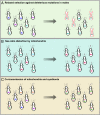Maternal transmission, sex ratio distortion, and mitochondria
- PMID: 25870270
- PMCID: PMC4547267
- DOI: 10.1073/pnas.1421391112
Maternal transmission, sex ratio distortion, and mitochondria
Abstract
In virtually all multicellular eukaryotes, mitochondria are transmitted exclusively through one parent, usually the mother. In this short review, we discuss some of the major consequences of uniparental transmission of mitochondria, including deleterious effects in males and selection for increased transmission through females. Many of these consequences, particularly sex ratio distortion, have well-studied parallels in other maternally transmitted genetic elements, such as bacterial endosymbionts of arthropods. We also discuss the consequences of linkage between mitochondria and other maternally transmitted genetic elements, including the role of cytonuclear incompatibilities in maintaining polymorphism. Finally, as a case study, we discuss a recently discovered maternally transmitted sex ratio distortion in an insect that is associated with extraordinarily divergent mitochondria.
Keywords: Wolbachia; cytoplasmic male sterility; genetic conflict; reproductive parasitism; symbiosis.
Conflict of interest statement
The authors declare no conflict of interest.
Figures




References
-
- Ballard J, Rand D. The population biology of mitochondrial DNA and its phylogenetic implications. Annu Rev Ecol Evol Syst. 2005;36:621–642.
-
- Ballard JW, Whitlock MC. The incomplete natural history of mitochondria. Mol Ecol. 2004;13(4):729–744. - PubMed
-
- Birky CW., Jr The inheritance of genes in mitochondria and chloroplasts: Laws, mechanisms, and models. Annu Rev Genet. 2001;35:125–148. - PubMed
-
- Burt A, Trivers R. Genes in Conflict: The Biology of Selfish Genetic Elements. Belknap; Cambridge, MA: 2006. Selfish mitochondrial DNA; pp. 142–184.
Publication types
MeSH terms
Substances
Associated data
- Actions
- Actions
- Actions
- Actions
- Actions
- Actions
- Actions
- Actions
- Actions
- Actions
- Actions
- Actions
LinkOut - more resources
Full Text Sources
Other Literature Sources

